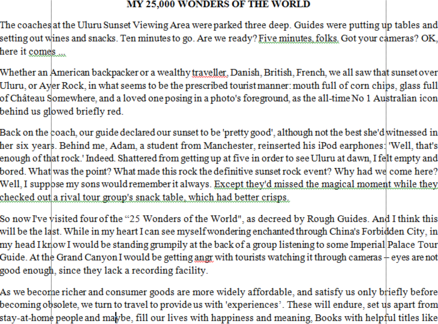Read the following passage and mark the letter A, B, C, or D to indicate the correct answer to each of the questions.The Native Americans of northern California were very good at basketry, using the reeds, grasses, barks, and roots they found around them to fashion articles of all sorts and sizes - not only trays, containers, and cooking pots, but hats, boats, fish traps, baby carriers, and ceremonial objects.Of all these experts, none excelled the Pomo - a group who lived on or near the coast...
Đọc tiếp
Read the following passage and mark the letter A, B, C, or D to indicate the correct answer to each of the questions.
The Native Americans of northern California were very good at basketry, using the reeds, grasses, barks, and roots they found around them to fashion articles of all sorts and sizes - not only trays, containers, and cooking pots, but hats, boats, fish traps, baby carriers, and ceremonial objects.
Of all these experts, none excelled the Pomo - a group who lived on or near the coast during the 1800's, and whose descendants continue to live in parts of the same region to this day. They made baskets three feet in diameter and others no bigger than a thimble. The Pomo people were masters of decoration. Some of their baskets were completely covered with shell pendants; others with feathers that made the baskets' surfaces as soft as the breasts of birds. Moreover, the Pomo people made use of more weaving techniques than did their neighbors. Most groups made all their basketwork by twining - the twisting of a flexible horizontal material, called a weft, around stiffer vertical strands of material, the warp, others depended primarily on coiling - a process in which a continuous coil of stiff material is held in the desired shape with tight wrapping of flexible strands. Only the Pomo people used both processes with equal ease and frequency. In addition, they made use of four distinct variations on the basic twining process, often employing more than one of them in a single article.
Although a wide variety of materials was available, the Pomo people used only a few. The warp was always made of willow, and the most commonly used weft was sedge root, a woody fiber that could easily be separated into strands no thicker than a thread. For color, the Pomo people used the bark of redbud for their twined work and dyed bulrush root for black in coiled work. Though other materials were sometimes used, these four were the staples in their finest basketry.
If the basketry materials used by the Pomo people were limited, the designs were amazingly varied. Every Pomo basketmaker knew how to produce from fifteen to twenty distinct patterns that could be combined in a number of different ways.
Question 1. The word "fashion" in line 2 is closest in meaning to____________.
A. maintain B. organize C. trade D. create
Question 2. The Pomo people used each of the following materials to decorate baskets EXCEPT_________.
A. shells B. feathers C. leaves D. bark
Question 3. What is the author's main point in the second paragraph?
A. The neighbors of the Pomo people tried to improve on the Pomo basket weaving techniques.
B. The Pomo people were the most skilled basket weavers in their region.
C. The Pomo people learned their basket weaving techniques from other Native Americans.
D. The Pomo baskets have been handed down for generations.
Question 4. According to the passage, a weft is a____________.
A. tool for separating sedge root B. process used for coloring baskets
C. pliable material woven around the warp D. pattern used to decorate baskets
Question 5. According to the passage, what did the Pomo people use as the warp in their baskets?
A. bulrush B. willow C. sedge D. redbud
Question 6. The word "staples" in line 21 is closest in meaning to____________.
A. combinations B. limitations C. accessories D. basic elements
Question 7. Which of the following statements about Pomo baskets can be best inferred from the passage?
A. Baskets produced by other Native Americans were less varied in design than those of the Pomo people.
B. Baskets produced by Pomo weavers were primarily for ceremonial purposes.
C. There were a very limited number of basket-making materials available to the Pomo people.
D. The basket-making production of the Pomo people has increased over the years.








Đáp án D
Thông tin: And yet viewing the main sight of any destination is rarely the highlight of a trip. Mostly it sits there on your itinerary like a duty visit to a dull relative.
Dịch: Tuy nhiên, việc xem cảnh chính của bất kỳ điểm đến nào hiếm khi là điểm nổi bật của một chuyến đi. Chủ yếu là nó ngồi đó trên hành trình của bạn như một chuyến thăm nghĩa vụ đến một người họ hàng buồn tẻ.